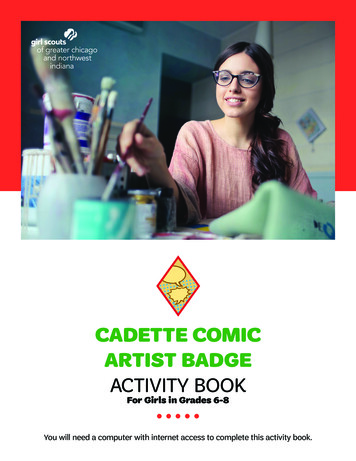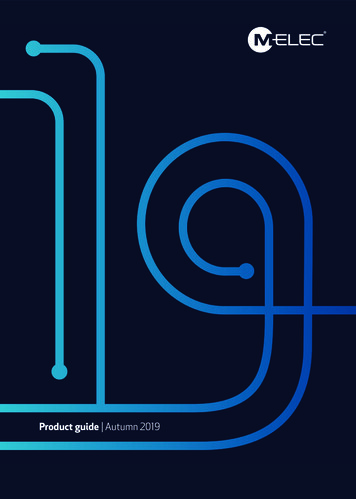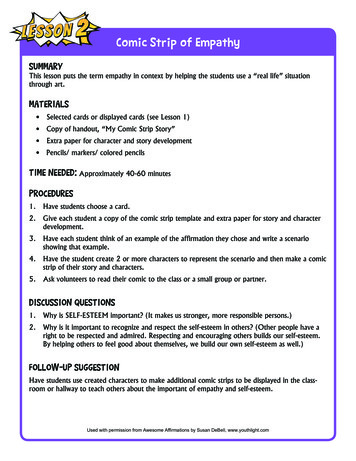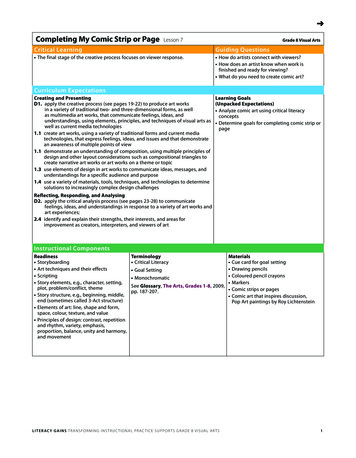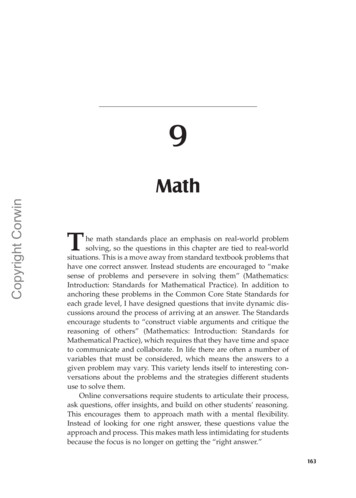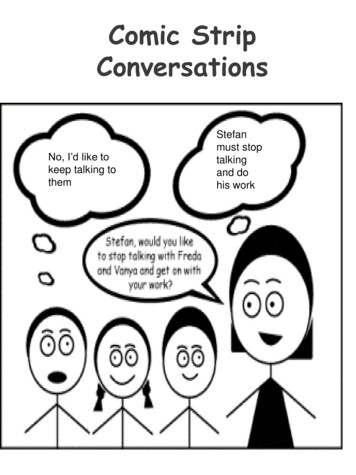
Transcription
Comic StripConversationsNo, I’d like tokeep talking tothemStefanmust stoptalkingand dohis work
Carol GrayCarol developed SocialStories in 1991 and theComic Strip Conversationshortly followed.These strategies are usedto teach socialunderstanding.A Comic StripConversation can be usedto clarify amisunderstanding – it canshow what was said andthought by the studentand can also show thethoughts of others.
What Are Comic Strip Conversations ?Individuals with ASD often haveproblems in social situations.They may not be able tounderstand or process speech asquickly as is needed for mostsocial interactions. A Comic StripConversation is a conversationbetween 2 or more people usingsimple drawings. This slows theconversation, allows you toforensically find out what wassaid and thought in a situationthat caused a problem.
Why would you use a Comic Strip Conversationwith a young person with autism? To engage in problem solving/ conflict resolutionwhere a social situation has been unsuccessful. To help a young person communicate their feelingsand perception of a situation (helping others tounderstand the experience from their point of view). To enable reflection in a non-threatening manner(“drawing the story” of what happened rather thanbeing asked lots of questions). It slows the conversation down, making it lessstressful and allowing time for verbal processing. The end product is visual and can be referred back topromoting understanding and learning. To help the young person understand why things wentwrong and work out a different course of action fornext time so they could successfully negotiate a similarsituation in future.
Elements Of Comic StripConversations Begin with drawing the event that caused theproblem.Where were you? Draw a symbol to representthe place and a stick person to represent thechild.Draw the key people that were involved inthe event.
Encourage the child to draw whatwas going onWhat happened?JamesLOSERTomWhat did others do? Draw relevant itemsand actions.
Use speech bubbles and thoughtbubblesI’MSCAREDI HATE YOUUse SpeechBubbles torecord whatwas said bythe studentand byothers.Use thought bubbles to show what thestudent was thinking and to show whatthe student thinks others may have beenthinking.
Correct their interpretation of what happened asnecessary.You could do post-it note overlays or a secondversion of the sketch, or just cross out the firstthought bubble and replace it with one that is moreaccurate.Thatboy isbadTheteacherthinksI’m bad.Thebehaviour ofthis class isdisgraceful!Some ofthesechildrenare badlybehaved.JoshTeacher
You may be able to draw asolution or idea of how to avoidthe situation happening againLOSERI will walk awayand ignore him.JamesTomYou can use smiley faces and sad faces toshow how people felt, and put a smileyface outcome after a solution as a way ofcoding good ideas.
EmotionsColour coding your Comic StripConversations.Some children will struggle identifyingthe thoughts, feelings and motivationsof others and may need help with this.You can agree with your student acolour code for their Comic Strip.Sometimes there can be lots of coloursfor different emotions, with a colourkey in the corner of the drawing. Oryou could try:RED –TEASING, UNFRIENDLY,ANGRY.BLUE – WORRIEDGREEN – HAPPY, FRIENDLY.But different colours mean differentthings to different people. Make surethe colours you use together arechosen by the student you are workingwith.
Useful questions to askWhere are you?Who else is here?What are you doing?What happened? What did othersdo? What did you say? What didothers say? What did you think when you saidthat? What did others think when theysaid that/did that?
You can also use a CSC to explain socialproblems like interruptingWhen people talk at the same time it iscalled interrupting. Interrupting meansour words bump into each other.This is very confusing and bad manners
You can even use favourite characters in acomic strip conversation if you want to makea poster to show how to respond to a socialsituation. For example:Patrick reacts inappropriately whenpeople in his environment use a loud voice.He created this comic strip conversationusing characters from his favourite TVshow to provide him with the appropriateresponse of "Ouch, that hurts my ears.Don't talk so loud, okay?" instead ofPatrick hitting the loud person in hisenvironment.
HIPATRICKDon’ttalk soloudly.O.K?I’m sorryPatrickOUCH!THATHURTSMYEARS
And finally. Remember youdon’t have to be awonderful artist to useComic Strip Conversations.Stick men, speech andthought bubbles are all youneed.
Example of a ComicStrip ConversationDuring a P.E lesson, playing rounder's, Francesca,who finds taking turns difficult, pushed in front ofPoppy whilst waiting to bat. Poppy challengedFrancesca which culminated in lots of shouting andFrancesca pushing Poppy.A key was agreed with Francesca and she addedgood thoughts and words to her initial drawings(these are in blue)Francesca was able to see the situation fromPoppy’s perspective and she apologised to Poppy.
Comic Strip Conversation shortly followed. These strategies are used to teach social understanding. A Comic Strip Conversation can be used to clarify a misunderstanding – it can show what was said and thought
